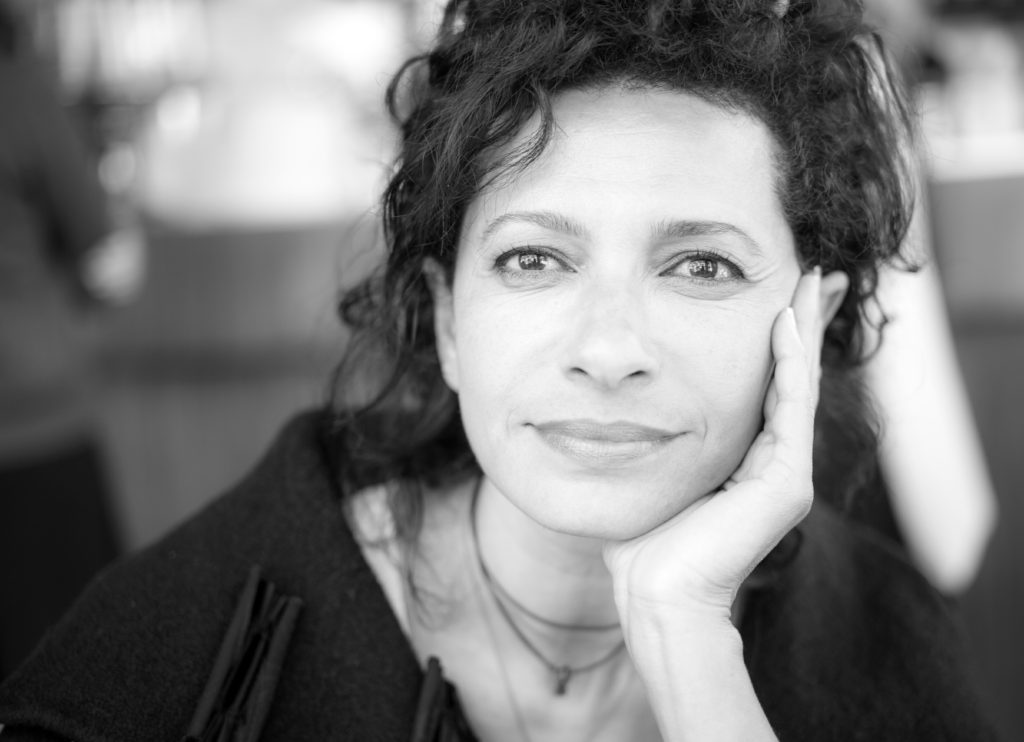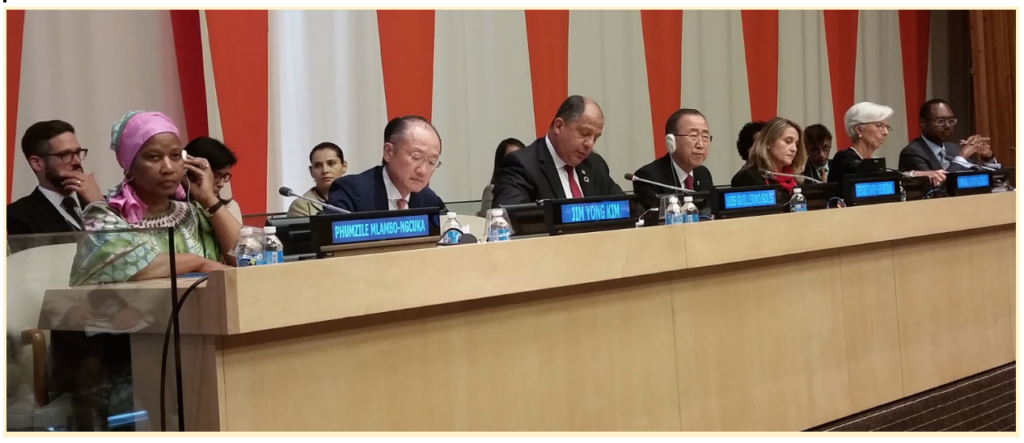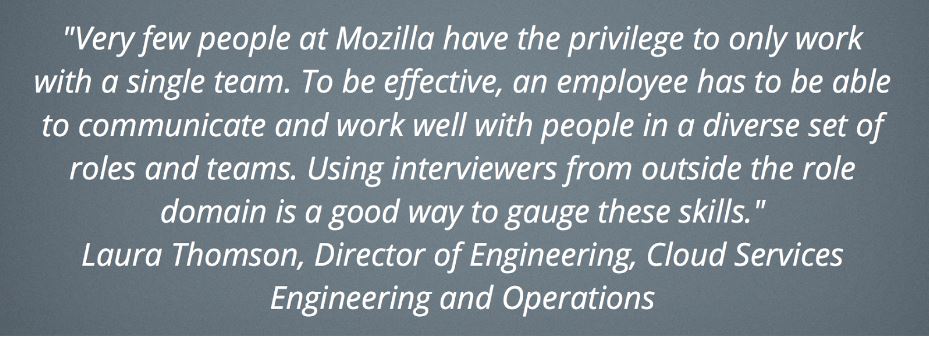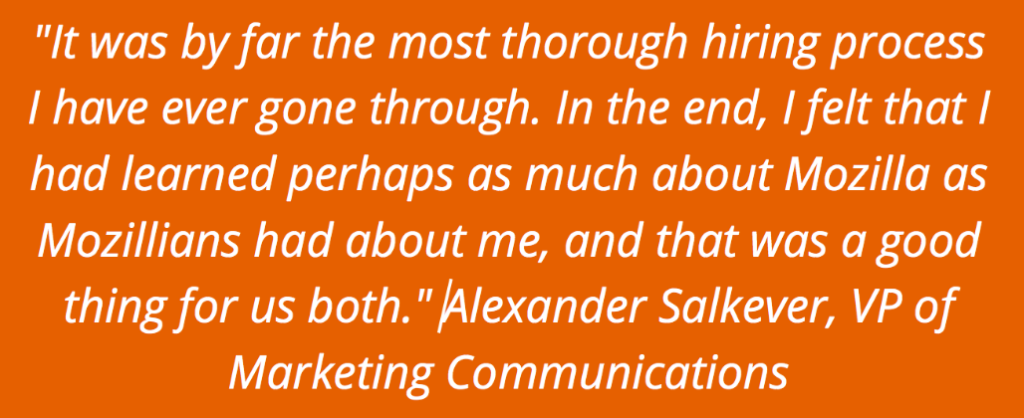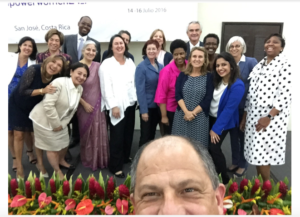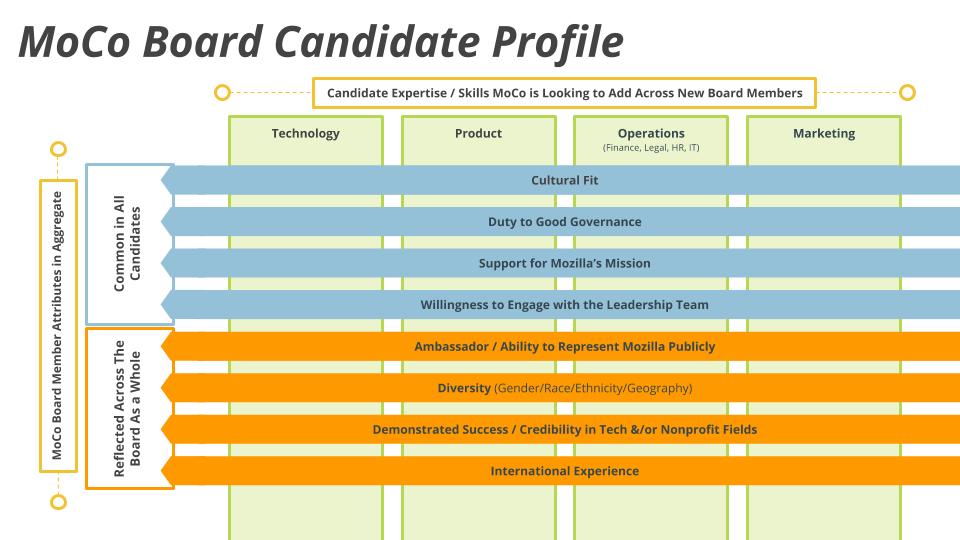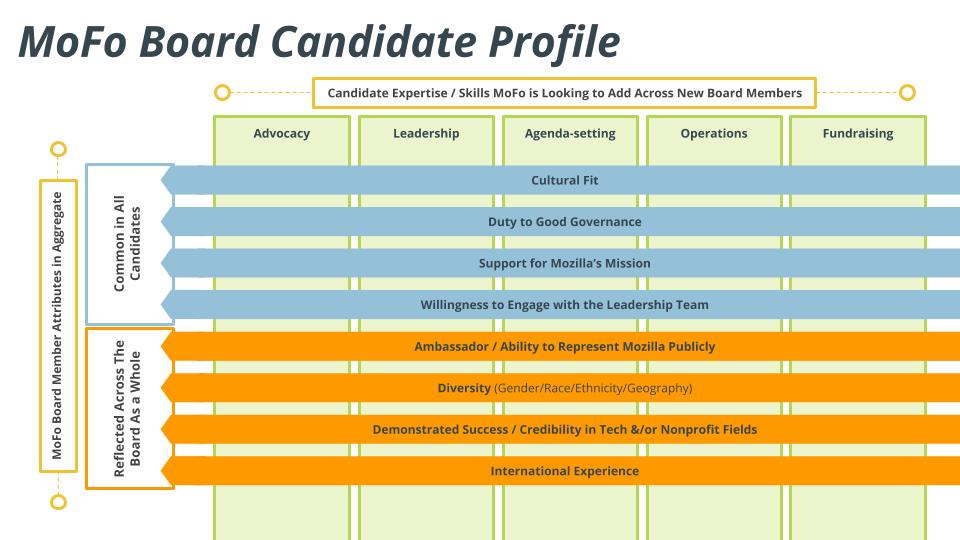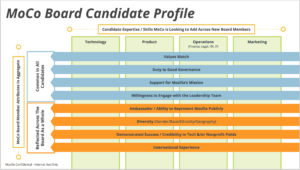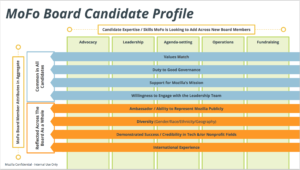Mitchell's Blog (original) (raw)
Julie Hanna Joins the Mozilla Corporation Board of Directors
December 1st, 2016
This post was originally posted on the Mozilla.org website.
Julie Hanna, new Mozilla Corporation Board member
Today, we are very pleased to announce the latest addition to the Mozilla Corporation Board of Directors – Julie Hanna. Julie is the Executive Chairman for Kiva and a Presidential Ambassador for Global Entrepreneurship and we couldn’t be more excited to have her joining our Board.
Throughout this year, we have been focused on board development for both the Mozilla Foundation and the Mozilla Corporation boards of directors. We envisioned a diverse group who embodied the same values and mission that Mozilla stands for. We want each person to contribute a unique point of view. After extensive conversations, it was clear to the Mozilla Corporation leadership team that Julie brings exactly the type of perspective and approach that we seek.
Born in Egypt, Julie has lived in various countries including Jordan and Lebanon before finally immigrating to the United States. Julie graduated from the University of Alabama at Birmingham with a B.S. in Computer Science. She currently serves as Executive Chairman at Kiva, a peer-peer lending pioneer and the world’s largest crowdlending marketplace for underserved entrepreneurs. During her tenure, Kiva has scaled its reach to 190+ countries and facilitated nearly 1billiondollarsinloansto2millionpeoplewitha971 billion dollars in loans to 2 million people with a 97% repayment rate. U.S. President Barack Obama appointed Julie as a Presidential Ambassador for Global Entrepreneurship to help develop the next generation of entrepreneurs. In that capacity, her signature initiative has delivered over 1billiondollarsinloansto2millionpeoplewitha97100M in capital to nearly 300,000 women and young entrepreneurs across 86 countries.
Julie is known as a serial entrepreneur with a focus on open source. She was a founder or founding executive at several innovative technology companies directly relevant to Mozilla’s world in browsers and open source. These include Scalix, a pioneering open source email/collaboration platform and developer of the most advanced AJAX application of its time, the first enterprise portal provider 2Bridge Software, and Portola Systems, which was acquired by Netscape Communications and become Netscape Mail.
She has also built a wealth of experience as an active investor and advisor to high-growth technology companies, including sharing economy pioneer Lyft, Lending Club and online retail innovator Bonobos. Julie also serves as an advisor to Idealab, Bill Gross’ highly regarded incubator which has launched dozens of IPO-destined companies.
Please join me in welcoming Julie Hanna to the Mozilla Board of Directors.
Mitchell
Background:
Twitter: @JulesHanna
Categories: Mozilla |
Mozilla Hosting the U.S. Commerce Department Digital Economy Board of Advisors
September 30th, 2016
Today Mozilla is hosting the second meeting of the Digital Economy Board of Advisors of the United States Department of Commerce, of which I am co-chair.
Support for the global open Internet is the heart of Mozilla’s identity and strategy. We build for the digital world. We see and understand the opportunities it offers, as well as the threats to its future. We live in a world where a free and open Internet is not available to all of the world’s citizens; where trust and security online cannot be taken for granted; and where independence and innovation are thwarted by powerful interests as often as they are protected by good public policy. As I noted in my original post on being named to the Board, these challenges are central to the “Digital Economy Agenda,” and a key reason why I agreed to participate.
Department of Commerce Secretary Pritzker noted earlier this year: “we are no longer moving toward the digital economy. We have arrived.” The purpose of the Board is to advise the Commerce Department in responding to today’s new status quo. Today technology provides platforms and opportunities that enable entrepreneurs with new opportunities. Yet not everyone shares the benefits. The changing nature of work must also be better understood. And we struggle to measure these gains, making it harder to design policies that maximize them, and harder still to defend the future of our digital economy against myopic and reactionary interests.
The Digital Economy Board of Advisors was convened to explore these challenges, and provide expert advice from a range of sectors of the digital economy to the Commerce Department as it develops future policies. At today’s meeting, working groups within the Board will present their initial findings. We don’t expect to agree on everything, of course. Our goal is to draw out the shared conclusions and direction to provide a balanced, sustainable, durable basis for future Commerce Department policy processes. I will follow up with another post on this topic shortly.
Today’s meeting is a public meeting. There will be two live streams: one for the 8:30 am-12:30 pm PT pre-lunch session and one for the afternoon post-lunch 1:30-3:00pm PT. We welcome you to join us.
Although the Board has many more months left in its tenure, I can see a trend towards healthy alignment between our mission and the outcomes of the Board’s activities. I’m proud to serve as co-chair of this esteemed group of individuals.
Categories: Mozilla |
UN High Level Panel and UN Secretary General Ban Ki-moon issue report on Women’s Economic Empowerment
September 28th, 2016
“Gender equality remains the greatest human rights challenge of our time.” UN Secretary General Ban Ki-moon, September 22, 2016.
To address this challenge the Secretary General championed the 2010 creation of UN Women, the UN’s newest entity. To focus attention on concrete actions in the economic sphere he created the “High Level Panel on Women’s Economic Empowerment” of which I am a member.
The Panel presented its initial findings and commitments last week during the UN General Assembly Session in New York. Here is the Secretary General, with the the co-chairs, and the heads of the IMF and the World Bank, the Executive Director of the UN Women, and the moderator and founder of All Africa Media, each of whom is a panel member.
Photo Credit: Anar Simpson
The findings are set out in the Panel’s initial report. Key to the report is the identification of drivers of change, which have been deemed by the panel to enhance women’s economic empowerment:
- Breaking stereotypes: Tackling adverse social norms and promoting positive role models
- Leveling the playing field for women: Ensuring legal protection and reforming discriminatory laws and regulations
- Investing in care: Recognizing, reducing and redistributing unpaid work and care
- Ensuring a fair share of assets: Building assets—Digital, financial and property
- Businesses creating opportunities: Changing business culture and practice
- Governments creating opportunities: Improving public sector practices in employment and procurement
- Enhancing women’s voices: Strengthening visibility, collective voice and representation
- Improving sex-disaggregated data and gender analysis
Chapter Four of the report describes a range of actions that are being undertaken by Panel Members for each of the above drivers. For example under the Building assets driver: DFID and the government of Tanzania are extending land rights to more than 150,000 Tanzanian women by the end of 2017. Tanzania will use media to educate people on women’s land rights and laws pertaining to property ownership. Clearly this is a concrete action that can serve as a precedent for others.
As a panel member, Mozilla is contributing to the working on Building Assets – Digital. Here is my statement during the session in New York:
“Mozilla is honored to be a part of this Panel. Our focus is digital inclusion. We know that access to the richness of the Internet can bring huge benefits to Women’s Economic Empowerment. We are working with technology companies in Silicon Valley and beyond to identify those activities which provide additional opportunity for women. Some of those companies are with us today.
Through our work on the Panel we have identified a significant interest among technology companies in finding ways to do more. We are building a working group with these companies and the governments of Costa Rica, Tanzania and the U.A. E. to address women’s economic empowerment through technology.
We expect the period from today’s report through the March meeting to be rich with activity. The possibilities are huge and the rewards great. We are committed to an internet that is open and accessible to all.”
You can watch a recording of the UN High Level Panel on Women’s Economic Empowerment here. For my statement, view starting at: 2.07.53.
There is an immense amount of work to be done to meet the greatest human rights challenge of our time. I left the Panel’s meeting hopeful that we are on the cusp of great progress.
Categories: Mozilla |
Living with Diverse Perspectives
September 23rd, 2016
Diversity and Inclusion is more than having people of different demographics in a group. It is also about having the resulting diversity of perspectives included in the decision-making and action of the group in a fundamental way.
I’ve had this experience lately, and it demonstrated to me both why it can be hard and why it’s so important. I’ve been working on a project where I’m the individual contributor doing the bulk of the work. This isn’t because there’s a big problem or conflict; instead it’s something I feel needs my personal touch. Once the project is complete, I’m happy to describe it with specifics. For now, I’ll describe it generally.
There’s a decision to be made. I connected with the person I most wanted to be comfortable with the idea to make sure it sounded good. I checked with our outside attorney just in case there was something I should know. I checked with the group of people who are most closely affected and would lead the decision and implementation if we proceed. I received lots of positive response.
Then one last person checked in with me from my first level of vetting and spoke up. He’s sorry for the delay, etc but has concerns. He wants us to explore a bunch of different options before deciding if we’ll go forward at all, and if so how.
At first I had that sinking feeling of “Oh bother, look at this. I am so sure we should do this and now there’s all this extra work and time and maybe change. Ugh!” I got up and walked around a bit and did a few thing that put me in a positive frame of mind. Then I realized — we had added this person to the group for two reasons. One, he’s awesome — both creative and effective. Second, he has a different perspective. We say we value that different perspective. We often seek out his opinion precisely because of that perspective.
This is the first time his perspective has pushed me to do more, or to do something differently, or perhaps even prevent me from something that I think I want to do. So this is the first time the different perspective is doing more than reinforcing what seemed right to me.
That lead me to think “OK, got to love those different perspectives” a little ruefully. But as I’ve been thinking about it I’ve come to internalize the value and to appreciate this perspective. I expect the end result will be more deeply thought out than I had planned. And it will take me longer to get there. But the end result will have investigated some key assumptions I started with. It will be better thought out, and better able to respond to challenges. It will be stronger.
I still can’t say I’m looking forward to the extra work. But I am looking forward to a decision that has a much stronger foundation. And I’m looking forward to the extra learning I’ll be doing, which I believe will bring ongoing value beyond this particular project.
I want to build Mozilla into an example of what a trustworthy organization looks like. I also want to build Mozilla so that it reflects experience from our global community and isn’t living in a geographic or demographic bubble. Having great people be part of a diverse Mozilla is part of that. Creating a welcoming environment that promotes the expression and positive reaction to different perspectives is also key. As we learn more and more about how to do this we will strengthen the ways we express our values in action and strengthen our overall effectiveness.
Categories: Mozilla |
Guest Post: Increasing the Level of Participation in the Hiring Process
September 2nd, 2016
This is a guest blog post from Jane Finette, Executive Program Manager, who works closely with me in Office of the Chair.
In a recent blog post Mitchell described why she has been eager to see the hiring process at Mozilla have a larger focus on cross-functional participation, particularly for senior leaders whom we expect to represent a broad swath of Mozilla. Enabling wider participation in how we hire for leadership has been our starting point. She notes we began organizing panel discussions for a broader set of people to talk to the candidate some time ago.
The need to hire for a new senior role, Vice President of Marketing Communications, presented an opportunity to further explore this new type of approach. Jascha Kaykas-Wolff, our CMO and the hiring manager for this role, and I sat down to plan and document some further experiments with the hiring process for this role. Our goal from the start was to explore two outcomes: an increased participation within the organization and the simultaneous creation of a meaningful process for candidates to evaluate us.
Enabling participation in the hiring process for the VP of MarComm position was particularly crucial because this person has a role that represents and communicates publicly about a broad swath of Mozilla. The VP of MarComms oversees the global communications, social media, user support and content marketing teams and works across the organization to develop impactful outbound communications for Mozilla and Firefox products.
What was the process?
Jascha and I designed the interview process right at the start with participation as one of the key objectives. Together we identified interviewers as peers, direct reports, expertise leaders and others who were not from the group where the candidate would work; in this case Marketing. We identified cross functional areas the hire would interact with on a regular and a geographic basis, these were people who might not otherwise have been part of the interview process.
Here is an overview of the process we devised:
1st round: Peers (no direct reports).
Purpose: Interviewing for values match, strong competency in area of expertise.
2nd round: Directs report + leaders in area of expertise, including cross-functional areas.
Purpose: Interviewing for leadership attributes, values match, competency in area of expertise.
3rd round: Panel – including moderator and panel members who were not part of the group where the candidate would work. Panel was a maximum of 7 people.
Purpose: Validate values match. Give insights into broader organizational dynamics.
4th round: Case study including peers + directs reports and a small selection of members of the panel. Maximum of 12 people.
Purpose: Place for the person to demonstrate their expertise and shine, and experience a typical environment.
5th round: CEO and Chairwoman
Purpose: Validate values match, leadership and skills where appropriate.
We conducted well over 50 screenings and entered 8 very well qualified candidates into our process. The process took approximately four months to complete, approximately the same amount of time required for an executive level hire.
What have we learned so far?
The hiring process for the VP of MarComm is now complete. Alex Salkever, joined Mozilla as our Vice President of Marketing Communications on May 18, 2016.
We have a hypothesis that increasing the level of diversity and participation will lead to stronger hires at Mozilla. We are continuing the pilot to explore this further.
(1) In our opinion interviews are both for the organization and the candidate
- By increasing the level of diverse participation, we have been able to get more input from across the organization, finding blind-spots and bias. In our pilot case, the role was intended to be hired outside of the US due to the global nature of the position. The hiring manager explained he was heavily influenced by his peers in the organization regarding the location of this hire, which could have led to a suboptimal situation if he had pushed with his original preference. Additionally, we chose a candidate who has strong technical chops for a Marcom lead and yet, the recommendation was shaped heavily by the feedback provided from the non-marketing/policy participants.
- We are exploring turning this into a repeatable interview process.
- We have created an environment where candidates can also evaluate us from multiple perspectives.
(i) By adding differing perspectives to our current hiring process, we are exposing a new hire to our unique culture and operating principles right from the start.
(ii) The new hire already knows and has the potential to have credibility with a significant number of people at Mozilla from the first day. The process is essentially a way of reputation building on a distributed basis.
(2) Participatory hiring process in senior levels is our starting point
- Our starting point for a more participatory hiring process is our senior roles. As Mitchell noted, “the more senior the role, the broader a part of Mozilla we expect someone to be able to lead, and the broader a sense of representing the entire organization we expect that person to have.” These roles require an ability to interact, motivate and work across teams, they also have the high potential to affect culture.
(3) Defining what success looks like helps identify who should participate in the hiring process
- A key practice to apply in all hiring processes: define (i) what success for the role will be and (ii) all the stakeholders in the organization whom can support success, this creates the pool of participants. In this case, we worked with both the hiring manager and the recruiter at the start of the process to design and determine the process.
(4) Add more people early on
- A previous learning indicated a broader group of diverse interviewees should be in the 3rd stage of the interview, not the last stage as their feedback proved to be critical in the decision process. This was upheld in this example. In order to invite a broad group to meet with a candidate, this could take the form of a panel to create an effective use of time.
Gotchas:
- We note that time taken by increasing participation in hiring could inhibit the process. In subsequent examples we intend to create and test a lightweight version of the process.
- When involving more people in the process, we must be careful to collect candidate feedback individually, as in larger group settings ‘group think’ can happen.
Often a standard type of interview process is designed for the company, rather than the individual being interviewed. The standard process is intended to maximize assessment in a core area of expertise, whereby candidates are evaluated by their manager, peers and direct reports in their domain only. This creates an unhealthy power balance and exposes a set of addressable biases in the process such as ones based on cultural fit, and skills gap perspectives from other areas of the company.
What’s next?
We will continue to explore, record results and share further findings. We have now begun another participatory hiring experiment at the ‘director’ level role. It’s an interesting question what piece of evidence would conclusively prove cross-functional and cross-level participation in hiring leadership brings benefits to an organization. We’ll continue to experiment.
Categories: Mozilla |
Practicing Open: Expanding Participation in Hiring Leadership
August 23rd, 2016
Last fall I came across a hiring practice that surprised me. We were hiring for a pretty senior position. When I looked into the interview schedule I realized that we didn’t have a clear process for the candidate to meet a broad cross-section of Mozillians. We had a good clear process for the candidate to meet peers and people in the candidate’s organization. But we didn’t have a mechanism to go broader.
This seemed inadequate to me, for two reasons. First, the more senior the role, the broader a part of Mozilla we expect someone to be able to lead, and the broader a sense of representing the entire organization we expect that person to have. Our hiring process should reflect this by giving the candidate and a broader section of people to interact.
Second, Mozilla’s core DNA is from the open source world, where one earns leadership by first demonstrating one’s competence to one’s peers. That makes Mozilla a tricky place to be hired as a leader. So many roles don’t have ways to earn leadership through demonstrating competence before being hired. We can’t make this paradox go away. So we should tune our hiring process to do a few things:
- Give candidates a chance to demonstrate their competence to the same set of people who hope they can lead. The more senior the role, the broader a part of Mozilla we expect someone to be able to lead.
- Expand the number of people who have a chance to make at least a preliminary assessment of a candidate’s readiness for a role. This isn’t the same as the open source ideal of working with someone for a while. But it is a big difference from never knowing or seeing or being consulted about a candidate. We want to increase the number of people who are engaged in the selection and then helping the newly hired person succeed.
We made a few changes right away, and we’re testing out how broadly these changes might be effective. Our immediate fix was to organize a broader set of people to talk to the candidate through a panel discussion. We aimed for a diverse group, from role to gender to geography. We don’t yet have a formalized way to do this, and so we can’t yet guarantee that we’re getting a representational group or that other potential criteria are met. However, another open source axiom is that “the perfect is the enemy of the good.” And so we started this with the goal of continual improvement. We’ve used the panel for a number of interviews since then.
We looked at this in more detail during the next senior leadership hire. Jascha Kaykas-Wolff, our Chief Marketing Officer, jumped on board, suggesting we try this out with the Vice President of Marketing Communications role he had open. Over the next few months Jane Finette (executive program manager, Office of the Chair) worked closely with Jascha to design and pilot a program of extending participation in the selection of our next VP of MarComm. Jane will describe that work in the next post. Here, I’ll simply note that the process was well received. Jane is now working on a similar process for the Director level.
Categories: Mozilla |
Practicing “Open” at Mozilla
August 17th, 2016
Mozilla works to bring openness and opportunity for all into the Internet and online life. We seek to reflect these values in how we operate. At our founding it was easy to understand what this meant in our workflow — developers worked with open code and project management through bugzilla. This was complemented with an open workflow through the social media of the day — mailing lists and the chat or “messenger” element, known as Internet Relay Chat (“irc”). The tools themselves were also open-source and the classic “virtuous circle” promoting openness was pretty clear.
Today the setting is different. We were wildly successful with the idea of engineers working in open systems. Today open source code and shared repositories are mainstream, and in many areas the best of practices and expected and default. On the other hand, the newer communication and workflow tools vary in their openness, with some particularly open and some closed proprietary code. Access and access control is a constant variable. In addition, at Mozilla we’ve added a bunch of new types of activities beyond engineering, we’ve increased the number of employees dramatically and we’re a bit behind on figuring out what practicing open in this setting means.
I’ve decided to dedicate time to this and look at ways to make sure our goals of building open practices into Mozilla are updated and more fully developed. This is one of the areas of focus I mentioned in an earlier post describing where I spend my time and energy.
So far we have three early stage pilots underway sponsored by the Office of the Chair:
- Opening up the leadership recruitment process to more people
- Designing inclusive decision-making practices
- Fostering meaningful conversations and exchange of knowledge across the organization, with a particular focus on bettering communications between Mozillians and leadership.
Follow-up posts will have more info about each of these projects. In general the goal of these experiments is to identify working models that can be adapted by others across Mozilla. And beyond that, to assist other Mozillians figure out new ways to “practice open” at Mozilla.
Categories: Mozilla |
Increasing Information Flow at Mozilla
August 15th, 2016
Information flow between leaders and individual contributors is critical to an effective organization. The ability to better understand the needs of the organization, to gather input across different domains, getting other perspectives before we make a decision and change management, help create a clueful and informed organisation.
This quarter we are piloting a number of untypical discussion sessions between leaders and individuals across Mozilla, whereby leaders will engage with participants who are not usually in their domain. There are hypotheses we’d like to test. One is that cross-team, multiple-level discussion and information flow will: prevent us from being blind-sided, increase our shared understanding, and empower people to participate and lead in productive ways. A second hypothesis is that there is an appetite for this type of discussion and some templates and structure would make it easier for people to know how to approach it.
We have 9 leaders who have agreed to host a discussion session this quarter, and we’re currently in the process of inviting participants from across the organization. Currently, there are 4 types of discussions we’ve identified that could take place, there are likely more:
- Pulse (“Taking the Pulse”) – allow a leader to quickly test an idea and/or get insights from the wider community about the current state of Mozilla, or their domain area.
- Ideation – to generate insights from a targeted and diverse group of participants.
- Decision – to ask for feedback regarding a decision from a broad group of people beyond the typical domain to ensure they are not blind-sided, and to provide key diverse input.
- Change Management – creates a shared understanding for a decision already made.
If these sessions prove useful, we may create a useful toolkit for leadership on how to run disperse discussion sessions, and gather input from across Mozilla. And in addition, create a toolkit for individual contributors for understanding and contributing to important topics across Mozilla.
We’ll plan to share more updates next month.
Categories: Mozilla | Tags: discussion, information flow |
Update on the United Nations High Level Panel on Women’s Economic Empowerment
July 22nd, 2016
It is critical to ensure that women are active participants in digital life. Without this we won’t reach full economic empowerment. This is the perspective and focus I bring to the UN High Level Panel for Women’s Economic Empowerment (HLP), which met last week in Costa Rica, hosted by President Luis Guillermo Solis.
(Here is the previous blog post on this topic.)
Many thanks to President Solis, who led with both commitment and authenticity. Here he shows his prowess with selfie-taking:
Members of the High Level Panel – From Left to Right: Tina Fordham, Citi Research; Laura Tyson, UC Berkeley; Alejandra Mora, Government of Costa Rica; Ahmadou Ba, AllAfrica Global Media; Renana Jhabvala, WIEGO; Elizabeth Vazquez, WeConnect; Jeni Klugman, Harvard Business School; Mitchell Baker, Mozilla; Gwen Hines, DFID-UK; Phumzile Mlambo, UN Women; José Manuel Salazar Xirinachs, International Labour Organization; Simona Scarpaleggia, Ikea; Winnie Byanyima, Oxfam; Fiza Farhan, Buksh Foundation; Karen Grown, World Bank; Margo Thomas, HLP Secretariat.
Photo Credit: Luis Guillermo Solis, President, Costa Rica
In the meeting we learned about actions the Panel members have initiated, and provided feedback and guidelines on the first draft of the HLP report. The goal for the report is to be as concrete as possible in describing actions in women’s economic empowerment which have shown positive results so that interested parties could adopt these successful practices. An initial version of the report will be released in September, with the final report in 2017. In the meantime, Panel members are also initiating, piloting and sometimes scaling activities that improve women’s economic empowerment.
As Phumzile Mlambo-Ngcuka, the Executive Director of UN Women often says, the best report will be one that points to projects that are known to work. One such example is a set of new initiatives, interventions and commitments to be undertaken in the Punjab, announced by the Panel Member and Deputy from Pakistan, Fiza Farhan and Mahwish Javaid.
Mozilla, too, is engaged in a set of new initiatives. We’ve been tuning our Mozilla Clubs program, which are on-going events to teach Web Literacy, to be interesting and more accessible to women and girls. We’ve entered into a partnership with UN Women to deepen this work and the pilots are underway. If you’d like to participate, consider applying your organizational, educational, or web skills to start a Mozilla Club for women and girls in your area. Here are examples of existing clubs for women in Nairobi and Cape Town.
Mozilla is also involved in the theme of digital inclusion as a cross-cutting, overarching theme of the HLP report. This is where Anar Simpson, my official Deputy for the Panel, focuses her work. We are liaising with companies in Silicon Valley who are working in the fields of connectivity and distribution of access to explore if, when and and how their projects can empower women economically. We’re looking to gather everything they have learned about what has been effective. In addition to this information/content gathering task, Mozilla is working with the Panel on the advocacy and publicity efforts of the report.
I joined the Panel because I see it as a valuable mechanism for driving both visibility and action on this topic. Women’s economic empowerment combines social justice, economic growth benefits and the chance for more stability in a fragile world. I look forward to meeting with the UN Panel again in September and reporting back on practical and research-driven initiatives.
Categories: Mozilla |
Expanding Mozilla’s Boards
June 14th, 2016
This post was originally published on the Mozilla Blog.
In a post earlier this month, I mentioned the importance of building a network of people who can help us identify and recruit potential Board level contributors and senior advisors. We are also currently working to expand both the Mozilla Foundation and Mozilla Corporation Boards.
The role of a Mozilla Board member
I’ve written a few posts about the role of the Board of Directors at Mozilla.
At Mozilla, we invite our Board members to be more involved with management, employees and volunteers than is generally the case. It’s not that common for Board members to have unstructured contacts with individuals or even sometimes the management team. The conventional thinking is that these types of relationships make it hard for the CEO to do his or her job. We feel differently. We have open flows of information in multiple channels. Part of building the world we want is to have built transparency and shared understandings.
We also prefer a reasonably extended “get to know each other” period for our Board members. Sometimes I hear people speak poorly of extended process, but I feel it’s very important for Mozilla. Mozilla is an unusual organization. We’re a technology powerhouse with a broad Internet openness and empowerment mission at its core. We feel like a product organization to those from the nonprofit world; we feel like a non-profit organization to those from the Internet industry.
It’s important that our Board members understand the full breadth of Mozilla’s mission. It’s important that Mozilla Foundation Board members understand why we build consumer products, why it happens in the subsidiary and why they cannot micro-manage this work. It is equally important that Mozilla Corporation Board members understand why we engage in the open Internet activities of the Mozilla Foundation and why we seek to develop complementary programs and shared goals.
I want all our Board members to understand that “empowering people” encompasses “user communities” but is much broader for Mozilla. Mozilla should be a resource for the set of people who care about the open Internet. We want people to look to Mozilla because we are such an excellent resource for openness online, not because we hope to “leverage our community” to do something that benefits us.
These sort of distinctions can be rather abstract in practice. So knowing someone well enough to be comfortable about these takes a while. We have a couple of ways of doing this. First, we have extensive discussions with a wide range of people. Board candidates will meet the existing Board members, members of the management team, individual contributors and volunteers. We’ve been piloting ways to work with potential Board candidates in some way. We’ve done that with Cathy Davidson, Ronaldo Lemos, Katharina Borchert and Karim Lakhani. We’re not sure we’ll be able to do it with everyone, and we don’t see it as a requirement. We do see this as a good way to get to know how someone thinks and works within the framework of the Mozilla mission. It helps us feel comfortable including someone at this senior level of stewardship.
What does a Mozilla Board member look like
Job descriptions often get long and wordy. We have those too but, for the search of new Board members, we’ve tried something else this time: a visual role description.
Board member job description for Mozilla Corporation
Board member job description for Mozilla Foundation
Here is a short explanation of how to read these visuals:
- The horizontal lines speaks to things that every Board member should have. For instance, to be a Board member, you have to care about the mission and you have to have some cultural sense of Mozilla, etc. They are a set of things that are important for each and every candidate. In addition, there is a set of things that are important for the Board as a whole. For instance, we could put international experience in there or whether the candidate is a public spokesperson. We want some of that but it is not necessary that every Board member has that.
- In the vertical green columns, we have the particular skills and expertise that we are looking for at this point.
- We would expect the horizontal lines not to change too much over time and the vertical lines to change depending on who joins the Board and who leaves.
I invite you to look at these documents and provide input on them. If you have candidates that you believe would be good Board members, send them to the boarddevelopment@mozilla.com mailing list. We will use real discretion with the names you send us.
We’ll also be designing a process for how to broaden participation in the process beyond other Board members. We want to take advantage of the awareness and the cluefulness of the organization. That will be part of a future update.
—
Update August 2, 2016
Both the Mozilla Foundation and Mozilla Corporation Board Candidate Profiles have been updated. Cultural Fit has been updated to ‘Values Match’.
Categories: Mozilla |
